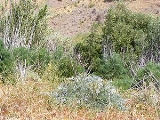
Invasive species in Australia
Encyclopedia
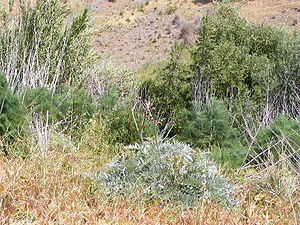
Invasive species
"Invasive species", or invasive exotics, is a nomenclature term and categorization phrase used for flora and fauna, and for specific restoration-preservation processes in native habitats, with several definitions....
are a serious threat to the native biodiversity
Biodiversity
Biodiversity is the degree of variation of life forms within a given ecosystem, biome, or an entire planet. Biodiversity is a measure of the health of ecosystems. Biodiversity is in part a function of climate. In terrestrial habitats, tropical regions are typically rich whereas polar regions...
of Australia
Australia
Australia , officially the Commonwealth of Australia, is a country in the Southern Hemisphere comprising the mainland of the Australian continent, the island of Tasmania, and numerous smaller islands in the Indian and Pacific Oceans. It is the world's sixth-largest country by total area...
and are an ongoing cost to Australian agriculture
Agriculture in Australia
Australia is a major agricultural producer and exporter. Agriculture and its closely related sectors earn $155 billion-a-year for a 12% share of GDP. Australian farmers and graziers own 135,996 farms, covering 61% of Australia’s landmass. There is a mix of irrigation and dry-land farming...
.
Management and the prevention of the introduction of new invasive species are key environmental and agricultural policy issues for the Australian federal and state governments. The management of weed
Weed
A weed in a general sense is a plant that is considered by the user of the term to be a nuisance, and normally applied to unwanted plants in human-controlled settings, especially farm fields and gardens, but also lawns, parks, woods, and other areas. More specifically, the term is often used to...
s costs A$
Australian dollar
The Australian dollar is the currency of the Commonwealth of Australia, including Christmas Island, Cocos Islands, and Norfolk Island, as well as the independent Pacific Island states of Kiribati, Nauru and Tuvalu...
3.5 billion yearly.
Diseases, fungi, and parasites
Invasive diseases, fungi, and parasites in Australia affect many native plants and animals and agricultural crops. Recently Citrus cankerCitrus canker
Citrus canker is a disease affecting citrus species that is caused by the bacterium Xanthomonas axonopodis. Infection causes lesions on the leaves, stems, and fruit of citrus trees, including lime, oranges, and grapefruit...
was introduced into Australia, and many Queensland citrus orchards have been burned to remove the disease. The fungus Phytophthora cinnamomi
Phytophthora cinnamomi
Phytophthora cinnamomi is a soil-borne water mould that produces an infection which causes a condition in plants called root rot or dieback. The plant pathogen is one of the world's most invasive species and is present in over 70 countries from around the world.- Life cycle and effects on plants :P...
, commonly known as Dieback, has created a massive problem in some types of native vegetation - especially Jarrah forest and Banksia woodland.
Feral animals (introduced species)
Australia is host to 56 introduced invasive vertebrate animal species. They can be categorised in the following ways:- InvasiveInvasive species"Invasive species", or invasive exotics, is a nomenclature term and categorization phrase used for flora and fauna, and for specific restoration-preservation processes in native habitats, with several definitions....
- species has a tendency to spread their range into new areas or plague their range - FeralFeralA feral organism is one that has changed from being domesticated to being wild or untamed. In the case of plants it is a movement from cultivated to uncultivated or controlled to volunteer. The introduction of feral animals or plants to their non-native regions, like any introduced species, may...
s - defined as animals for domestic purposes (i.e. petPetA pet is a household animal kept for companionship and a person's enjoyment, as opposed to wild animals or to livestock, laboratory animals, working animals or sport animals, which are kept for economic or productive reasons. The most popular pets are noted for their loyal or playful...
s, recreational use - such as hunting - or beasts of burdenWorking animalA working animal is an animal, usually domesticated, that is kept by humans and trained to perform tasks. They may be close members of the family, such as guide or service dogs, or they may be animals trained strictly to perform a job, such as logging elephants. They may also be used for milk, a...
) which have gone wild. - Pests - animals which have a direct effect on human standard of living or the environment/ecosystems in areas where they are present, have a high rate of reproduction and are difficult to control
Feral animals causing most public concern and economic and ecological damage include:
| Image | Name | Species | Overview | Introduced | Reason | Introduced from | Distribution | Feral | Pest | Threat level | Est. pop. | Main control measures | Notes / ref |
|---|---|---|---|---|---|---|---|---|---|---|---|---|---|
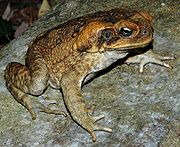 |
Cane toad Cane toads in Australia The cane toad is an invasive species in Australia. The cane toad is the largest species in the family Bufonidae. Adult cane toads are usually heavy-built and weigh an average of up to 1.8kg. . Their size may vary from 15-23 cm. and their skin is warty... |
Bufo marinus Cane Toad The Cane Toad , also known as the Giant Neotropical Toad or Marine Toad, is a large, terrestrial true toad which is native to Central and South America, but has been introduced to various islands throughout Oceania and the Caribbean... |
Cane toads in Australia Cane toads in Australia The cane toad is an invasive species in Australia. The cane toad is the largest species in the family Bufonidae. Adult cane toads are usually heavy-built and weigh an average of up to 1.8kg. . Their size may vary from 15-23 cm. and their skin is warty... |
1935 | Biological control (cane beetle Cane beetle The cane beetle, Dermolepida albohirtum, is a native Australian beetle and a pest of the sugar cane. Adult beetles eat the leaves of sugar cane but greater damage is the done by their larvae hatching underground and eating the roots, which either kills or stunts the growth of the plant.Larvae,... ) |
South America via Hawaii | Queensland Queensland Queensland is a state of Australia, occupying the north-eastern section of the mainland continent. It is bordered by the Northern Territory, South Australia and New South Wales to the west, south-west and south respectively. To the east, Queensland is bordered by the Coral Sea and Pacific Ocean... (extensive), northern New South Wales New South Wales New South Wales is a state of :Australia, located in the east of the country. It is bordered by Queensland, Victoria and South Australia to the north, south and west respectively. To the east, the state is bordered by the Tasman Sea, which forms part of the Pacific Ocean. New South Wales... , Top End Top End The Top End of northern Australia is the second northernmost point on the continent. It covers a rather vaguely-defined area of perhaps 400,000 square kilometres behind the northern coast from the Northern Territory capital of Darwin across to Arnhem Land with the Indian Ocean on the west, the... , Kimberley |
No | Yes | Extreme | 200 million + | Culling; trapping; genetic (under research) | prolific breeders and bufotoxin Bufotoxin Bufotoxins are a family of toxic substances found in the parotoid glands, skin and venom of many toads ; other amphibians; and some plants and mushrooms. The exact composition varies greatly with the specific source of the toxin. It can contain: 5-MeO-DMT, bufagins, bufotalin, bufotenine,... kills native animals |
 |
Red Fox Red Fox The red fox is the largest of the true foxes, as well as being the most geographically spread member of the Carnivora, being distributed across the entire northern hemisphere from the Arctic Circle to North Africa, Central America, and the steppes of Asia... |
Vulpes vulpes | Feral foxes in Australia Feral foxes in Australia Feral foxes pose a serious conservation problem in Australia.The red fox was introduced to Australia in the 19th century for hunting in 1843 near Melbourne, but has since become widespread, and is considered responsible for the decline in a number of species of native animals in the "critical... |
1855 | Recreational hunting | Europe | most of mainland Australia; small numbers in Tasmania | No | Yes | Extreme | 7.2 million + | 1080 baiting; hunting | Elusive prolific predator of native animals and livestock. |
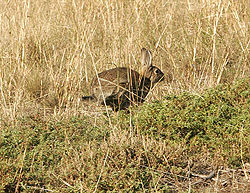 |
European Rabbit European Rabbit The European Rabbit or Common Rabbit is a species of rabbit native to south west Europe and north west Africa . It has been widely introduced elsewhere often with devastating effects on local biodiversity... |
Oryctolagus cuniculus | Rabbits in Australia Rabbits in Australia In Australia, rabbits are a serious mammalian pest and are an invasive species. Annually, European rabbits cause millions of dollars of damage to crops.-Effects on Australia's ecology:... |
1859 | Recreational hunting | Europe | Throughout Australia (extensive) | No | Yes | High | 200 million + | rabbit-proof fence Rabbit-proof fence The State Barrier Fence of Western Australia, formerly known as the No. 1 Rabbit-proof Fence, the State Vermin Fence and the Emu Fence, is a pest-exclusion fence constructed between 1901 and 1907 to keep rabbits and other agricultural pests, from the east, out of Western Australian pastoral... ; Myxomatosis Myxomatosis Myxomatosis is a disease that affects rabbits and is caused by the Myxoma virus. It was first observed in Uruguay in laboratory rabbits in the late 19th century. It was introduced into Australia in 1950 in an attempt to control the rabbit population... ; Calicivirus (RHD) |
Prolific breeders that destroy land. |
 |
Dromedary Camel | Camelus dromedarius Dromedary The dromedary or Arabian camel is a large, even-toed ungulate with one hump on its back. Its native range is unclear, but it was probably the Arabian Peninsula. The domesticated form occurs widely in North Africa and the Middle East... |
Australian feral camel Australian feral camel Thousands of the two main species of Australian feral camels, mostly dromedaries but also some bactrian camels, were imported into Australia during the 19th century for transport and construction as part of the colonisation of the central and western parts of Australia. Motorised transport replaced... |
1840 | Beast of burden | India | Central Australia (extensive) | Yes | Yes | Medium to high | 1.1 million | Helicopter culling | Grazer, though arid Australian conditions suit the camel perfectly. |
 |
Feral goat Feral goat The feral goat is the domestic goat when it has become established in the wild. Feral goats occur in Australia, New Zealand, Ireland, Great Britain, Hawaii, the Galapagos and in many other parts of the world... |
Capra hircus Goat The domestic goat is a subspecies of goat domesticated from the wild goat of southwest Asia and Eastern Europe. The goat is a member of the Bovidae family and is closely related to the sheep as both are in the goat-antelope subfamily Caprinae. There are over three hundred distinct breeds of... |
Feral goats in Australia Feral goats in Australia Feral goats are an invasive animal species in Australia.-History:Goats originally came to Australia with the First Fleet in 1788. These goats were the ancestors of the feral goat populations present in Australia today. During the 19th Century, the goats were set free by mariners as a measure to... |
?? | Domestic Domestication Domestication or taming is the process whereby a population of animals or plants, through a process of selection, becomes accustomed to human provision and control. In the Convention on Biological Diversity a domesticated species is defined as a 'species in which the evolutionary process has been... livestock Livestock Livestock refers to one or more domesticated animals raised in an agricultural setting to produce commodities such as food, fiber and labor. The term "livestock" as used in this article does not include poultry or farmed fish; however the inclusion of these, especially poultry, within the meaning... |
?? | Throughout Australia (extensive) | Yes | Yes | High | + | Helicopter culling | |
| Feral cat Feral cat A feral cat is a descendant of a domesticated cat that has returned to the wild. It is distinguished from a stray cat, which is a pet cat that has been lost or abandoned, while feral cats are born in the wild; the offspring of a stray cat can be considered feral if born in the wild.In many parts of... |
Felis catus Cat The cat , also known as the domestic cat or housecat to distinguish it from other felids and felines, is a small, usually furry, domesticated, carnivorous mammal that is valued by humans for its companionship and for its ability to hunt vermin and household pests... |
Feral cat | c. 1700s | Pets | Europe | Throughout Australia, except in tropical rainforests (extensive) | Yes | Yes | High to extreme | ?? | Barrier fencing, shooting, trapping. Control measures effective on small islands; less so on the mainland. | The most widely spread and invasive of all introduced species. It is possibly responsible for the extinction of some species of small mammals. | |
| Brumby Brumby A Brumby is a free-roaming feral horse in Australia. Although found in many areas around the country, the best-known brumbies are found in the Australian Alps region in south-eastern Australia. Today, most of them are found in the Northern Territory, with the second largest population in Queensland... |
Equus ferus caballus Horse The horse is one of two extant subspecies of Equus ferus, or the wild horse. It is a single-hooved mammal belonging to the taxonomic family Equidae. The horse has evolved over the past 45 to 55 million years from a small multi-toed creature into the large, single-toed animal of today... |
Brumby Brumby A Brumby is a free-roaming feral horse in Australia. Although found in many areas around the country, the best-known brumbies are found in the Australian Alps region in south-eastern Australia. Today, most of them are found in the Northern Territory, with the second largest population in Queensland... |
1788 First Fleet The First Fleet is the name given to the eleven ships which sailed from Great Britain on 13 May 1787 with about 1,487 people, including 778 convicts , to establish the first European colony in Australia, in the region which Captain Cook had named New South Wales. The fleet was led by Captain ... |
Farm and utility work | Europe; some later imports from South Africa South Africa The Republic of South Africa is a country in southern Africa. Located at the southern tip of Africa, it is divided into nine provinces, with of coastline on the Atlantic and Indian oceans... and Indonesia Indonesia Indonesia , officially the Republic of Indonesia , is a country in Southeast Asia and Oceania. Indonesia is an archipelago comprising approximately 13,000 islands. It has 33 provinces with over 238 million people, and is the world's fourth most populous country. Indonesia is a republic, with an... |
Throughout Australia (extensive) | Yes | Yes | Medium to high | 300,000+ | Musters, ground and helicopter culling, fertility control | Grazers that damage sensitive lands | |
| Feral pig | Sus scrofa | Feral pig | 1788 First Fleet The First Fleet is the name given to the eleven ships which sailed from Great Britain on 13 May 1787 with about 1,487 people, including 778 convicts , to establish the first European colony in Australia, in the region which Captain Cook had named New South Wales. The fleet was led by Captain ... |
Domestic Domestication Domestication or taming is the process whereby a population of animals or plants, through a process of selection, becomes accustomed to human provision and control. In the Convention on Biological Diversity a domesticated species is defined as a 'species in which the evolutionary process has been... livestock Livestock Livestock refers to one or more domesticated animals raised in an agricultural setting to produce commodities such as food, fiber and labor. The term "livestock" as used in this article does not include poultry or farmed fish; however the inclusion of these, especially poultry, within the meaning... |
Europe | Throughout Australia, except in deserts (extensive) | Yes | Yes | High | 13 million to 23 million | Musters, ground and helicopter culling, trapping, poisoning, fencing | Prolific breeders that destroy land and have the potential to spread disease |
- feral donkeyDonkeyThe donkey or ass, Equus africanus asinus, is a domesticated member of the Equidae or horse family. The wild ancestor of the donkey is the African Wild Ass, E...
s (Equus asinusDonkeyThe donkey or ass, Equus africanus asinus, is a domesticated member of the Equidae or horse family. The wild ancestor of the donkey is the African Wild Ass, E...
), see Feral donkeys in AustraliaFeral donkeys in AustraliaFeral donkeys in Australia are donkeys which escaped from captivity, and are living and breeding in the wild.Donkeys originated in Africa and also parts of Asia. They are a part of the Equidae family... - feral African Wild AssAfrican Wild AssThe African Wild Ass is a wild member of the horse family, Equidae. This species is believed to be the ancestor of the domestic donkey which is usually placed within the same species. They live in the deserts and other arid areas of northeastern Africa, in Eritrea, Ethiopia and Somalia; it...
(Equus africanusAfrican Wild AssThe African Wild Ass is a wild member of the horse family, Equidae. This species is believed to be the ancestor of the domestic donkey which is usually placed within the same species. They live in the deserts and other arid areas of northeastern Africa, in Eritrea, Ethiopia and Somalia; it...
) - feral Water BuffaloWater BuffaloThe water buffalo or domestic Asian water buffalo is a large bovine animal, frequently used as livestock in southern Asia, and also widely in South America, southern Europe, northern Africa, and elsewhere....
(Bubalus bubalisWater BuffaloThe water buffalo or domestic Asian water buffalo is a large bovine animal, frequently used as livestock in southern Asia, and also widely in South America, southern Europe, northern Africa, and elsewhere....
) - House GeckoHemidactylusHemidactylus is a genus of the family of typical geckos, Gekkonidae. It is the second-most speciose genus in the family, with about 90 described species, newfound ones being described every few years. These geckos are found in all the tropical regions of the world, extending into the subtropical...
Feral animals have very few predators in Australia.
Control
Various programs exist to control invasive species in Australia. A cane toad control program aims at preventing the spread of the species towards DarwinDarwin, Northern Territory
Darwin is the capital city of the Northern Territory, Australia. Situated on the Timor Sea, Darwin has a population of 127,500, making it by far the largest and most populated city in the sparsely populated Northern Territory, but the least populous of all Australia's capital cities...
and Western Australia
Western Australia
Western Australia is a state of Australia, occupying the entire western third of the Australian continent. It is bounded by the Indian Ocean to the north and west, the Great Australian Bight and Indian Ocean to the south, the Northern Territory to the north-east and South Australia to the south-east...
, and involves trapping. Foxes are often baited, although the use of 1080 (sodium fluoroacetate) is also known to affect native animals such as the Quoll
Quoll
The quoll, or native cat, is a carnivorous marsupial native to mainland Australia, New Guinea and Tasmania. It is primarily nocturnal and spends most of the day in its den. There are six species of quoll; four are found in Australia and two in New Guinea...
and Tasmanian Devil
Tasmanian Devil
The Tasmanian devil is a carnivorous marsupial of the family Dasyuridae, now found in the wild only on the Australian island state of Tasmania. The size of a small dog, it became the largest carnivorous marsupial in the world following the extinction of the thylacine in 1936...
, though the most common and effective method is shooting. 1080 is ideal in the South-West of Australia because a native plant contains the same toxin - therefore most native animals have developed immunity to it. Other species are either open to hunting as a sport (such as the deer) or subject to government sponsored culling
Culling
Culling is the process of removing animals from a group based on specific criteria. This is done either to reinforce certain desirable characteristics or to remove certain undesirable characteristics from the group...
programs. Camels and buffalo are often shot from helicopter
Helicopter
A helicopter is a type of rotorcraft in which lift and thrust are supplied by one or more engine-driven rotors. This allows the helicopter to take off and land vertically, to hover, and to fly forwards, backwards, and laterally...
s.
Bounties
Several bounty programs have assisted in the eradication of larger sized pests in Australia.
Ironically, many early bounties were paid for the extermination of native species that were considered a pest to farmers. The Tasmanian tiger or thylacine
Thylacine
The thylacine or ,also ;binomial name: Thylacinus cynocephalus, Greek for "dog-headed pouched one") was the largest known carnivorous marsupial of modern times. It is commonly known as the Tasmanian tiger or the Tasmanian wolf...
was one such program that caused extinction, whilst the Tasmanian Devil
Tasmanian Devil
The Tasmanian devil is a carnivorous marsupial of the family Dasyuridae, now found in the wild only on the Australian island state of Tasmania. The size of a small dog, it became the largest carnivorous marsupial in the world following the extinction of the thylacine in 1936...
, Spotted Quoll
Tiger Quoll
The tiger quoll , also known as the spotted-tail quoll, the spotted quoll, the spotted-tailed dasyure or the tiger cat, is a carnivorous marsupial of the quoll genus Dasyurus native to Australia...
, and Tasmanian Wedge-tailed Eagle
Wedge-tailed Eagle
The Wedge-tailed Eagle , sometimes known as the Eaglehawk in its native range, is the largest bird of prey in Australia, but it is also found in southern New Guinea. It has long, fairly broad wings, fully feathered legs, and an unmistakable wedge-shaped tail...
all became seriously threatened by bounties.
At various times, bounties have been in place for invasive species such as wild-living domestic dogs (including the dingo
Dingo
The Australian Dingo or Warrigal is a free-roaming wild dog unique to the continent of Australia, mainly found in the outback. Its original ancestors are thought to have arrived with humans from southeast Asia thousands of years ago, when dogs were still relatively undomesticated and closer to...
) and fox
Fox
Fox is a common name for many species of omnivorous mammals belonging to the Canidae family. Foxes are small to medium-sized canids , characterized by possessing a long narrow snout, and a bushy tail .Members of about 37 species are referred to as foxes, of which only 12 species actually belong to...
. A beer-for-toads bounty has been publicised for cane toad
Cane Toad
The Cane Toad , also known as the Giant Neotropical Toad or Marine Toad, is a large, terrestrial true toad which is native to Central and South America, but has been introduced to various islands throughout Oceania and the Caribbean...
control in the Northern Territory
Northern Territory
The Northern Territory is a federal territory of Australia, occupying much of the centre of the mainland continent, as well as the central northern regions...
In 2002, a Victorian Fox Bounty Trial began to test the efficacy of fox bounties which have been in place intermittently since 1893 (only 30 years after introduction). The study showed no reduction in fox impacts, and that the project may even have been counterproductive. The evaluation also found that
a sustained annual reduction of 65% is required to achieve real declines in fox populations.
Feral cat bounties in Queensland have also been considered to counter the growing problem. The dingo
Dingo
The Australian Dingo or Warrigal is a free-roaming wild dog unique to the continent of Australia, mainly found in the outback. Its original ancestors are thought to have arrived with humans from southeast Asia thousands of years ago, when dogs were still relatively undomesticated and closer to...
is subject to various controversial bounty system
Bounty (reward)
A bounty is a payment or reward often offered by a group as an incentive for the accomplishment of a task by someone usually not associated with the group. Bounties are most commonly issued for the capture or retrieval of a person or object. They are typically in the form of money...
s in Australia. The Australian dingo was itself introduced before European settlement, yet has been considered native of the mainland in most cases and is considered a pest to livestock.
Invasive birds
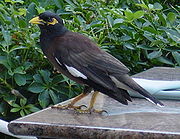
Common Myna
The Common Myna or Indian Myna also sometimes spelled Mynah, is a member of family Sturnidae native to Asia. An omnivorous open woodland bird with a strong territorial instinct, the Myna has adapted extremely well to urban environments...
, the Common Starling
European Starling
The Common Starling , also known as the European Starling or just Starling, is a passerine bird in the family Sturnidae.This species of starling is native to most of temperate Europe and western Asia...
, and Rock Pigeon
Rock Pigeon
The Rock Dove or Rock Pigeon, is a member of the bird family Columbidae . In common usage, this bird is often simply referred to as the "pigeon"....
(common pigeon).
Initially introduced to control locust plagues, the Indian Mynah breeds prolifically in urban environments in the eastern states. The mynah poses a serious threat (such that it has been listed in the World Conservation Union's world's 100 worst invasive species). The bird has caused human health concerns due to the spread of mites and disease and it has also been known to force native birds and their eggs from their nests.
The Rock Pigeon in particular has acid
Acid
An acid is a substance which reacts with a base. Commonly, acids can be identified as tasting sour, reacting with metals such as calcium, and bases like sodium carbonate. Aqueous acids have a pH of less than 7, where an acid of lower pH is typically stronger, and turn blue litmus paper red...
ic faeces
Feces
Feces, faeces, or fæces is a waste product from an animal's digestive tract expelled through the anus or cloaca during defecation.-Etymology:...
and can create a mess which damages human property including historic stone buildings.
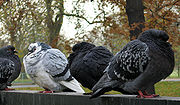
Control
There are currently no major controls in place for invasive birds in Australia.Programs promoting indigenous plantations to attract native birds are generally not helping the situation.
Starlings and sparrows are currently closely monitored in south-eastern Western Australia.
Despite the number of Rock Pigeons, many people continue to feed the birds bread crumbs and assist them to breed in great numbers. It is not yet illegal to feed pigeons in Australia, and many local proposals to cull pigeons have been rejected.
Invasive freshwater fish species
Invasive freshwater fish species in Australia include carpCommon carp
The Common carp is a widespread freshwater fish of eutrophic waters in lakes and large rivers in Europe and Asia. The wild populations are considered vulnerable to extinction, but the species has also been domesticated and introduced into environments worldwide, and is often considered an invasive...
, brown trout
Brown trout
The brown trout and the sea trout are fish of the same species....
, rainbow trout
Rainbow trout
The rainbow trout is a species of salmonid native to tributaries of the Pacific Ocean in Asia and North America. The steelhead is a sea run rainbow trout usually returning to freshwater to spawn after 2 to 3 years at sea. In other words, rainbow trout and steelhead trout are the same species....
, redfin perch
European perch
The European perch, Perca fluviatilis, is a predatory species of perch found in Europe and Asia. In some areas it is known as the redfin perch or English perch, and it is often known simply as perch. The species is a popular quarry for anglers and has been widely introduced beyond its native area,...
, mosquitofish
Mosquitofish in Australia
Mosquitofish were introduced to Australia in 1925, spreading from the northeast coasts south to New South Wales, Southern Australia, and parts of Western Australia by 1934...
(Gambusia spp), weather loach
Misgurnus
Misgurnus is a genus of loaches. Commonly known as weatherfishes or weather loaches, they are commonly eaten in Asia.- Species :* Misgurnus anguillicaudatus * Misgurnus buphoensis R. T. Kim & S. Y...
, and spotted tilapia
Spotted tilapia
The spotted tilapia is a West African fresh and brackish water fish of the cichlid family7. It is also commonly known as the spotted mangrove cichlid or black mangrove cichlid. Spotted mangrove cichlids have a short rounded snout and three anal spines1...
to name a few. Some introduced freshwater fish species have had devastating impacts on Australia's endemic freshwater fish species and other native aquatic life. For example in much of south eastern Australia's freshwater systems introduced carp (often incorrectly called "European" carp) dominate the lowland reaches, while introduced trout species almost completely dominate the upland reaches. While the damaging impact of carp is well recognised, little in the way of control measures have been employed to control their spread. Their ability to colonise almost any body of water, even those previously considered to be beyond their physical tolerances, is now well established.
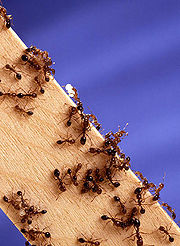
Insects and other invertebrates
Problem insectInsect
Insects are a class of living creatures within the arthropods that have a chitinous exoskeleton, a three-part body , three pairs of jointed legs, compound eyes, and two antennae...
s include red imported fire ant
Red imported fire ant
See main article Fire ant.The red imported fire ant , or simply RIFA, is one of over 280 species in the widespread genus Solenopsis...
s (Solenopsis invicta), yellow crazy ant
Yellow crazy ant
The yellow crazy ant is a species of ant, introduced accidentally to northern Australia and Christmas Island in the Indian Ocean, that has wreaked ecological damage in both locations....
s (Anoplolepis gracilipes), Black Portuguese millipede (Ommatoiulus moreletii), Western honey bee
European honey bee
The Western honey bee or European honey bee is a species of honey bee. The genus Apis is Latin for "bee", and mellifera comes from Latin melli- "honey" and ferre "to bear"—hence the scientific name means "honey-bearing bee"...
s (Apis mellifera), and European wasp
German wasp
The German wasp, or European wasp, Vespula germanica, is a wasp found in much of the Northern Hemisphere, native to Europe, northern Africa, and temperate Asia. It has been introduced and is well-established in many other places, including North America, South America , Australia and New Zealand...
s (Vespula germanica; known elsewhere by the common name "German wasps").
The elm leaf beetle (Pyrrhalta luteola), discovered in Victoria in 1989 devastates exotic elm tree
Elm
Elms are deciduous and semi-deciduous trees comprising the genus Ulmus in the plant family Ulmaceae. The dozens of species are found in temperate and tropical-montane regions of North America and Eurasia, ranging southward into Indonesia. Elms are components of many kinds of natural forests...
s, themselves imported, and a parasite wasp species as well as the beetle's natural enemy the parasitic fly (Erynniopsis antennata) were in turn introduced in 2001 in an effort to control the pest.
Control
Both the honey bee and European wasp are well established and now impossible to eradicate in Australia. Honey bees take over potential nesting hollows for native animals and are very hard to remove once established.The fire ant in particular, with its poisonous stings, poses a direct threat to human lifestyle. Although control is extremely difficult and spread quickly, the species is currently effectively quarantined to South East Queensland.
The yellow crazy ant
Yellow crazy ant
The yellow crazy ant is a species of ant, introduced accidentally to northern Australia and Christmas Island in the Indian Ocean, that has wreaked ecological damage in both locations....
is currently quarantined to Christmas Island
Christmas Island
The Territory of Christmas Island is a territory of Australia in the Indian Ocean. It is located northwest of the Western Australian city of Perth, south of the Indonesian capital, Jakarta, and ENE of the Cocos Islands....
where it has had a significant environmental impact.
Introduced marine pests
A number of marine pests have arrived in Australia in the ballast water of cargo ships. Marine pests include the black-striped musselBlack-striped mussel
The black-striped mussel, scientific name Mytilopsis sallei, is a small marine bivalve mollusc in the family Dreissenidae, the false mussels.It is closely related and ecologically similar to the zebra mussel, Dreissena polymorpha.-Distribution:...
(Mytilopsis sallei), the Asian mussel
Asian mussel
The Asian mussel, Musculista senhousia, is a small saltwater mussel, a marine bivalve mollusk species in the family Mytilidae. Its common names include: the Asian date mussel, the Japanese mussel, Senhouse's mussel, the green mussel and the green bagmussel...
, the New Zealand green-lipped mussel
New Zealand green-lipped mussel
The New Zealand green-lipped mussel, is a bivalve mollusc in the family Mytilidae. P. canaliculus has great importance as a cultivated species for New Zealand.-Distribution:Perna canaliculus has a wide distribution which covers all of New Zealand's mainland. P...
, and the European shore crab
Carcinus maenas
Carcinus maenas is a common littoral crab, and an important invasive species, listed among the 100 "world's worst alien invasive species". It is native to the north-east Atlantic Ocean and Baltic Sea, but has colonised similar habitats in Australia, South Africa, South America and both Atlantic and...
. The Northern Pacific seastar
Northern Pacific seastar
Asterias amurensis, commonly called the northern Pacific starfish, is an invasive species in Australia, and native to the coasts of northern China, North Korea, South Korea, Russia and Japan. Distribution of this species into other countries has increased...
in Tasmania
Tasmania
Tasmania is an Australian island and state. It is south of the continent, separated by Bass Strait. The state includes the island of Tasmania—the 26th largest island in the world—and the surrounding islands. The state has a population of 507,626 , of whom almost half reside in the greater Hobart...
, Inverloch
Inverloch, Victoria
Inverloch is a seaside village in Victoria, Australia. It is located on the Bass Highway 143 kilometres southeast of Melbourne, at the mouth of Anderson Inlet, in the Bass Coast Shire and is located close to Australia’s southernmost stand of mangroves...
, and Port Phillip
Port Phillip
Port Phillip Port Phillip Port Phillip (also commonly referred to as Port Phillip Bay or (locally) just The Bay, is a large bay in southern Victoria, Australia; it is the location of Melbourne. Geographically, the bay covers and the shore stretches roughly . Although it is extremely shallow for...
has caused much localised environmental damage.
Weeds
WeedWeed
A weed in a general sense is a plant that is considered by the user of the term to be a nuisance, and normally applied to unwanted plants in human-controlled settings, especially farm fields and gardens, but also lawns, parks, woods, and other areas. More specifically, the term is often used to...
s invade natural landscapes, waterways, and agricultural land. A list of Weeds of National Significance (WONS) was created in 1999. It includes the species in the following table.
| Common Name | Scientific Name | Extent in Australia | Image |
|---|---|---|---|
| Alligator Weed | Alternanthera philoxeroides | WA Western Australia Western Australia is a state of Australia, occupying the entire western third of the Australian continent. It is bounded by the Indian Ocean to the north and west, the Great Australian Bight and Indian Ocean to the south, the Northern Territory to the north-east and South Australia to the south-east... , NT Northern Territory The Northern Territory is a federal territory of Australia, occupying much of the centre of the mainland continent, as well as the central northern regions... , QLD Queensland Queensland is a state of Australia, occupying the north-eastern section of the mainland continent. It is bordered by the Northern Territory, South Australia and New South Wales to the west, south-west and south respectively. To the east, Queensland is bordered by the Coral Sea and Pacific Ocean... , NSW New South Wales New South Wales is a state of :Australia, located in the east of the country. It is bordered by Queensland, Victoria and South Australia to the north, south and west respectively. To the east, the state is bordered by the Tasman Sea, which forms part of the Pacific Ocean. New South Wales... , VIC Victoria (Australia) Victoria is the second most populous state in Australia. Geographically the smallest mainland state, Victoria is bordered by New South Wales, South Australia, and Tasmania on Boundary Islet to the north, west and south respectively.... , SA South Australia South Australia is a state of Australia in the southern central part of the country. It covers some of the most arid parts of the continent; with a total land area of , it is the fourth largest of Australia's six states and two territories.South Australia shares borders with all of the mainland... , TAS Tasmania Tasmania is an Australian island and state. It is south of the continent, separated by Bass Strait. The state includes the island of Tasmania—the 26th largest island in the world—and the surrounding islands. The state has a population of 507,626 , of whom almost half reside in the greater Hobart... |
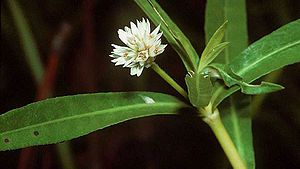 |
| Athel Pine | Tamarix aphylla Tamarix aphylla Tamarix aphylla is the largest known species of Tamarix . The species has a variety of common names, including Athel pine, Athel tree, Athel tamarisk, and saltcedar... |
WA, NT, QLD, NSW, VIC, SA | 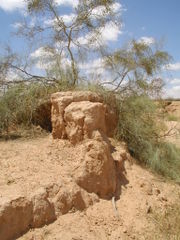 |
| Bitou bush / Boneseed | Chrysanthemoides monilifera Boneseed in Australia Boneseed or Bitou Bush is an invasive species in AustraliaBoneseed was introduced to Australia as an ornamental garden plant from the mid-nineteenth century, with examples first recorded in gardens in Sydney in 1852 and Melbourne in 1858... |
WA, QLD, NSW, VIC, SA, TAS | |
| Blackberry Blackberry The blackberry is an edible fruit produced by any of several species in the Rubus genus of the Rosaceae family. The fruit is not a true berry; botanically it is termed an aggregate fruit, composed of small drupelets. The plants typically have biennial canes and perennial roots. Blackberries and... |
Rubus fruticosus agg. | WA, QLD, NSW, VIC, SA, TAS, ACT Australian Capital Territory The Australian Capital Territory, often abbreviated ACT, is the capital territory of the Commonwealth of Australia and is the smallest self-governing internal territory... |
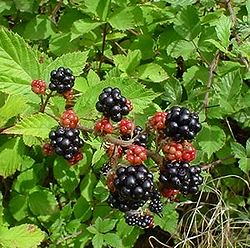 |
| Bridal Creeper | Asparagus asparagoides Asparagus asparagoides Asparagus asparagoides, commonly known as Bridal creeper, Bridal-veil creeper, Gnarboola, Smilax or Smilax asparagus, is a herbaceous climbing plant of the family Asparagaceae native to tropical and southern Africa... |
WA, NSW, VIC, SA, TAS | 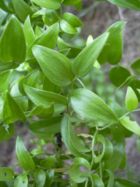 |
| Cabomba | Cabomba caroliniana Cabomba caroliniana Cabomba caroliniana, commonly known as Green Cabomba, is an aquatic perennial herbaceous plant native to North America. It is a Weed of National Significance in Australia.-Distribution:... |
NT, QLD, NSW, VIC | |
| Chilean Needle Grass | Nassella Nassella Nassella is a New World genus of about 115 perennial bunchgrasses found from North America through South America. The Latin name nassa means "a basket with a narrow neck." It is now a segregate from the genus Stipa and includes many New World species formerly classified in that genus.Nasella is... neesiana |
NSW, VIC, SA, ACT | |
| Common Gorse | Ulex europaeus | WA, QLD, NSW, VIC, SA, TAS, ACT | |
| Hymenachne Hymenachne Hymenachne is a genus of grass in the Poaceae family.- External links :*... |
Hymenachne amplexicaulis | NT, QLD, SA | |
| Lantana Lantana Lantana is a genus of about 150 species of perennial flowering plants in the verbena family, Verbenaceae. They are native to tropical regions of the Americas and Africa but exist as an introduced species in numerous areas, especially in the Australian-Pacific region. The genus includes both... |
Lantana camara Lantana camara Lantana camara, also known as Spanish Flag or West Indian Lantana, is a species of flowering plant in the verbena family, Verbenaceae, that is native to the American tropics. It has been introduced into other parts of the world as an ornamental plant and is considered an invasive species in many... |
WA, NT, QLD, NSW |  |
| Mesquite Mesquite Mesquite is a leguminous plant of the Prosopis genus found in northern Mexico through the Sonoran Desert and Chihuahuan Deserts, and up into the Southwestern United States as far north as southern Kansas, west to the Colorado Desert in California,and east to the eastern fifth of Texas, where... |
Prosopis spp. | WA, NT, QLD, NSW, VIC, SA |  |
| Mimosa Mimosa Mimosa is a genus of about 400 species of herbs and shrubs, in the subfamily Mimosoideae of the legume family Fabaceae. The generic name is derived from the Greek word μιμος , meaning "mimic."... |
Mimosa pigra Mimosa pigra Mimosa pigra , is an invasive species of the genus Mimosa, in the family Fabaceae. It is native to the Neotropics, but has been listed as one of the world's 100 worst invasive species, and has been documented in: Australia, Cambodia, Dominican Republic, Ghana, Guinea, Indonesia, Kenya, Malaysia,... |
NT |  |
| Parkinsonia | Parkinsonia aculeata Parkinsonia aculeata Parkinsonia aculeata is a species of perennial flowering tree in the pea family, Fabaceae. Common names include palo verde, Mexican palo verde, Parkinsonia, Jerusalem thorn, and jelly bean tree.-Etymology:... |
WA, NT, QLD | 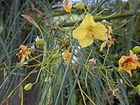 |
| Parthenium Parthenium Parthenium is a genus of flowering plants in the aster family, Asteraceae. The name is derived from either the Greek word παρθένος , meaning "virgin," or παρθένιον , an ancient name for a plant. Members of the genus are commonly known as feverfew. Notable species include Guayule and P... weed |
Parthenium hysterophorus | QLD, NSW, VIC | |
| Pond-apple | Annona glabra | NT, QLD, NSW | 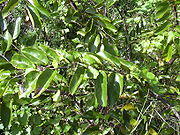 |
| Prickly Acacia | Acacia nilotica Acacia nilotica Acacia nilotica is a species of Acacia native to Africa and the Indian subcontinent... ssp. indica |
QLD, NSW | |
| Rubber Vine | Cryptostegia grandiflora | WA, QLD |  |
| Giant salvinia | Salvinia molesta | WA, NT, QLD, NSW, SA | 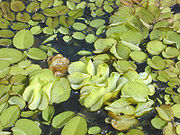 |
| Serrated Tussock | Nassella trichotoma Nassella trichotoma Nassella trichotoma is a type of bunchgrass plant, native in Argentina, Uruguay, Chile, and Peru.It is considered a weed of national significance in Australia, reducing the productivity of pasture and creating a fire hazard. In many states, landowners are required by law to keep their land free of... |
NSW, VIC, TAS, ACT |  |
| Willow Willow Willows, sallows, and osiers form the genus Salix, around 400 species of deciduous trees and shrubs, found primarily on moist soils in cold and temperate regions of the Northern Hemisphere... s |
Salix spp. except S. babylonica, S. X calodendron and S. X reichardtiji | NSW, VIC, ACT, SA |  |
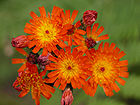
- African BoxthornBoxthornBoxthorn is a genus of the nightshade family , containing about 90 species of plants native throughout much of the temperate and subtropical zones of the world...
(Lycium ferocissimum) - Artichoke ThistleCardoonThe cardoon , also called the artichoke thistle, cardone, cardoni, carduni or cardi, is a thistle-like plant in the aster family Asteraceae. It is the naturally occurring form of the same species as the globe artichoke, and has many cultivated varieties...
/ Cardoon (Cynara cardunculus) - Cylindropuntia roseaCylindropuntia roseaCylindropuntia rosea, the Hudson Pear, is a cactus Australian botanists attribute to being native to the Sonoran Desert in Arizona and Northwestern Mexico. The plant is an invasive species in Australia. Neither this species name, C. rosea, nor C...
(Hudson Pear) has long, strong spines that are capable of piercing tyres and injuring animals. - Bellyache bushJatrophaJatropha is a genus of approximately 175 succulent plants, shrubs and trees , from the family Euphorbiaceae. The name is derived from the Greek words ἰατρός , meaning "physician," and τροφή , meaning "nutrition," hence the common name physic nut. Mature plants produce separate male and female...
(Jatropha gossypifolia) - Chinee AppleZiziphus mauritianaZiziphus mauritiana, also known as Jujube, Chinee Apple, Indian plum, and permseret , is a tropical fruit tree species belonging to the family Rhamnaceae....
/ chonky apple / Indian jujube (Ziziphus mauritiana) - Blue heliotrope (Heliotropium amplexicauleHeliotropium amplexicauleHeliotropium amplexicaule is a species of heliotrope known by several common names, including clasping heliotrope, blue heliotrope, and summer heliotrope. It is native to South America, especially Argentina, but it is known on several other continents where it is an introduced species, and in some...
) competes with desirable pastures and causes toxicity to livestockLivestockLivestock refers to one or more domesticated animals raised in an agricultural setting to produce commodities such as food, fiber and labor. The term "livestock" as used in this article does not include poultry or farmed fish; however the inclusion of these, especially poultry, within the meaning...
. - BrackenBrackenBracken are several species of large, coarse ferns of the genus Pteridium. Ferns are vascular plants that have alternating generations, large plants that produce spores and small plants that produce sex cells . Brackens are in the family Dennstaedtiaceae, which are noted for their large, highly...
competes with desirable pastures and causes toxicity to stock. - Mickey Mouse Plant (Ochna serrulataOchna serrulataOchna serrulata is an ornamental garden plant of the Ochnaceae family which is indigenous to South Africa...
) - Prickly pearPrickly pears in AustraliaPrickly pears are an invasive plant species in Australia.Prickly pears were imported into Australia in the 19th century for use as a natural agricultural fence and in an attempt to establish a cochineal dye industry. They quickly became a widespread invasive species, rendering of farming land...
(Opuntia spp.) - Orange HawkweedPilosella aurantiacaPilosella aurantiaca is a flowering plant of the family Asteraceae native to alpine regions of central and southern Europe, where it is protected in several regions.It is a low-growing plant with shallow fibrous roots and a basal rosette of elliptical to lanceolate...
(Pilosella aurantiaca) - Patterson's CursePatterson's CurseEchium plantagineum, commonly known as Purple Viper's Bugloss, is a species of Echium, native to western and southern Europe , northern Africa, and southwestern Asia . It has also been introduced to Australia, South Africa and United States and is an invasive plant...
/ Salvation Jane (Echium plantagineum) competes with desirable pastures and causes toxicity to stock. - St John's wortSt John's wortSt John's wort is the plant species Hypericum perforatum, and is also known as Tipton's Weed, Chase-devil, or Klamath weed....
(Hypericum perforatum) competes with desirable pastures and causes toxicity to stock. - Turkey Rhubarb (Acetosa sagittataAcetosa sagittataAcetosa sagittata, commonly known as turkey rhubarb or rambling dock or potato vine, is a herbaceous perennial plant native to southern Africa, which has become a weed in Australia and New Zealand.-Taxonomy:...
) - Water hyacinthWater hyacinthThe seven species of water hyacinth comprise the genus Eichhornia. Water hyacinth are a free-floating perennial aquatic plant native to tropical and sub-tropical South America. With broad, thick, glossy, ovate leaves, water hyacinth may rise above the surface of the water as much as 1 meter in...
(Eichhornia spp.) - Water lettucePistiaPistia is a genus of aquatic plant in the arum family, Araceae. The single species it comprises, Pistia stratiotes, is often called water cabbage, water lettuce, or Nile cabbage. Its native distribution is uncertain, but probably pantropical; it was first described from the Nile near Lake Victoria...
(Pistia spp.)
Weed management costs the Australian economy A$
Australian dollar
The Australian dollar is the currency of the Commonwealth of Australia, including Christmas Island, Cocos Islands, and Norfolk Island, as well as the independent Pacific Island states of Kiribati, Nauru and Tuvalu...
4 billion yearly; weeds are an environmental problem, the second greatest threat to biodiversity after land clearing. Almost half of Australia's 220 declared noxious weeds
Noxious weeds
A noxious weed is an invasive species of a plant that has been designated by country, state or provincial, or national agricultural authorities as one that is injurious to agricultural and/or horticultural crops, natural habitats and/or ecosystems, and/or humans or livestock...
(under legislation) were introduced deliberately, one third of these as garden ornamentals.
Management of invasive species
The management of invasive species is carried out by individuals, conservation groups, and government agencies.The Australian Quarantine and Inspection Service
Australian Quarantine and Inspection Service
The Australian Quarantine and Inspection Service is the Australian government agency responsible for enforcing Australian quarantine laws...
is responsible for ensuring that no new species with the potential to become invasive species enter Australia. To raise public awareness, Australian Quarantine has featured Australian celebrity nature lover Steve Irwin
Steve Irwin
Stephen Robert "Steve" Irwin , nicknamed "The Crocodile Hunter", was an Australian television personality, wildlife expert, and conservationist. Irwin achieved worldwide fame from the television series The Crocodile Hunter, an internationally broadcast wildlife documentary series which he co-hosted...
on a series of television commercial
Television advertisement
A television advertisement or television commercial, often just commercial, advert, ad, or ad-film – is a span of television programming produced and paid for by an organization that conveys a message, typically one intended to market a product...
s, with the message Quarantine - Don't mess with it.
Several scientific bodies are involved in research for the control of invasive species. The CSIRO
Commonwealth Scientific and Industrial Research Organisation
The Commonwealth Scientific and Industrial Research Organisation is the national government body for scientific research in Australia...
has released several successful biological pest control
Biological pest control
Biological control of pests in agriculture is a method of controlling pests that relies on predation, parasitism, herbivory, or other natural mechanisms...
agents and developed chemical agents for pest and weed control. For example, the CSIRO released myxoma
Myxomatosis
Myxomatosis is a disease that affects rabbits and is caused by the Myxoma virus. It was first observed in Uruguay in laboratory rabbits in the late 19th century. It was introduced into Australia in 1950 in an attempt to control the rabbit population...
virus to control wild rabbits in Australia.
Rabbit haemorrhagic disease escaped containment from an Australian Government research facility and spread across Australia. Rabbit hemorrhagic disease was subsequently legalised for the control of wild rabbits. The moth Cactoblastis cactorum
Cactoblastis cactorum
Cactoblastis cactorum, commonly known as the Cactus Moth, South American Cactus Moth, or Nopal Moth, is native to Argentina, Paraguay, Uruguay, and southern Brazil. It is one of five species in the genus Cactoblastis that lives in South America...
was introduced for the control of prickly pear, and the salvinia weevil Cyrtobagous salviniae
Cyrtobagous salviniae
Cyrtobagous salviniae is a species of weevil known as the salvinia weevil. It is used as an agent of biological pest control against the noxious aquatic plant giant salvinia ....
for the control of aquatic weed Salvinia
Salvinia
Salvinia, a genus in the family Salviniaceae, is a floating fern named in honor of Antonio Maria Salvini, a 17th Century Italian scientist. The genus was published by Séguier, in Pl. Veron. 3: 52. 1754. About ten species exist....
. More doubtful biological controls were the cane toad
Cane Toad
The Cane Toad , also known as the Giant Neotropical Toad or Marine Toad, is a large, terrestrial true toad which is native to Central and South America, but has been introduced to various islands throughout Oceania and the Caribbean...
, which was introduced to control the sugar cane destroying cane beetle; instead the cane toad ate anything and everything else—the beetle was not its preferred food source given choice. The cane toad in Australia has become the biological control that is most infamous for having been a complete failure as well as becoming an environmental nightmare. It has also led to much public concern and caution when considering the introduction of new biological controls.
Another example of a poorly researched introduced biological control is the sap sucking lantana bug (Aconophora compressa) also from South America that was introduced into Australia in the 1995 to eat the lantana. Unfortunately, the lantana bug also attacks other trees including fiddlewood trees which has caused distress to some gardeners. The lantana bug had been tested for six years on 62 different plants. Aconophora compressa was the 28th insect introduced to control lantana in about 80 years.
More successfully, the Australian Dung Beetle Project
Australian Dung Beetle Project
The Australian Dung Beetle Project , conceived and led by Dr. George Bornemissza, of the Commonwealth Scientific and Industrial Research Organisation , was an international scientific research and biological control project with the primary goal to introduce foreign species of dung beetle to...
(1965–1985), led by Dr. George Bornemissza
George Bornemissza
George Francis Bornemissza is a Hungarian-born entomologist and ecologist. He studied science at the University of Budapest before obtaining his PhD in zoology at the University of Innsbruck in Austria in 1950. At the end of that year he emigrated to Australia...
of CSIRO's Division of Entomology, introduced 23 species of dung beetle
Dung beetle
Dung beetles are beetles that feed partly or exclusively on feces. All of these species belong to the superfamily Scarabaeoidea; most of them to the subfamilies Scarabaeinae and Aphodiinae of the family Scarabaeidae. This beetle can also be referred to as the scarab beetle. As most species of...
to Australia in order to biologically control the pestilent population of bush flies. These flies, along with other species of fly and parasitic worm, use the dung as a breeding and feeding ground. The rolling and burying activity of the dung beetles means that the dung is removed from the pasture land, which had the effect of reducing bush fly number by 90%, as well increasing soil fertility and quality by recycling the dung back into the soil.
Cooperative Research Centre
Cooperative Research Centre
Cooperative Research Centres are key bodies for Australian scientific research. The Cooperative Research Centres Program was established in 1990 to enhance Australia's industrial, commercial and economic growth through the development of sustained, user-driven, cooperative public-private research...
s for weed management and pest animal control, have been established by the federal government. They coordinate research and funding between a number of university and government labs for research into control of invasive species.
World Trade Organisation and Australia's quarantine regulations
The World Trade OrganisationWorld Trade Organization
The World Trade Organization is an organization that intends to supervise and liberalize international trade. The organization officially commenced on January 1, 1995 under the Marrakech Agreement, replacing the General Agreement on Tariffs and Trade , which commenced in 1948...
specified quarantine regulations are weaker than Australia's fairly stringent regulations controlling the importing of raw produce. Following Australia's membership of the WTO, many forms of raw produce once banned have commenced import, with potentially adverse affects and controversy; for example, regarding proposals to import apples from New Zealand or bananas from the Philippines.
The weakening of restrictions on importing raw produce into Australia mandated by the World Trade Organisation Future may pose risks of introducing exotic disease organisms. Case examples include, Chytrid
Chytridiomycota
Chytridiomycota is a division of the Fungi kingdom. The name is derived from the Greek chytridion, meaning "little pot", describing the structure containing unreleased spores. In older classifications, chytrids were placed in the Class Phycomycetes under the subdivision Myxomycophyta of the...
fungus that is threatening numerous Australian frog species with extinction, and mass pilchards deaths in the Southern Ocean from 1995 onwards that are suspected to have been caused by a virus that may have been brought in with imported pilchards.
See also
- Asian musselAsian musselThe Asian mussel, Musculista senhousia, is a small saltwater mussel, a marine bivalve mollusk species in the family Mytilidae. Its common names include: the Asian date mussel, the Japanese mussel, Senhouse's mussel, the green mussel and the green bagmussel...
(Musculista senhousia) - Invasive species in New ZealandInvasive species in New ZealandA number of introduced species, some of which have become invasive species, have been added to New Zealand's native flora and fauna.Both deliberate and accidental introductions have been made from the time of the first human settlement with several waves of Polynesian people at some time before the...
- Environmental issues in AustraliaEnvironmental issues in AustraliaEnvironmental issues in Australia describes a number of environmental issues which affect the environment of Australia. There are a range of such issues, some of them relating to conservation in Australia while others, for example the deteriorating state of Murray-Darling Basin, have a direct and...
External links
- Invasive Species Council
- Full list of noxious weeds in Australia (.pdf)
- CSIRO Cane Toad research page
- CSIRO Research on Introduced Marine Pests
- The Cooperative Research Centre for Australian Weed Management
- CSIRO marine pest fact sheets
- The Department of Environment and Heritage, Invasive Species
- Weeds of National Significance
- The Cooperative Research Centre for Pest Animal Control
- feral.org.au
- Rabbit Information Service

